Electrocatalytic Degradation of Rhodamine B Using Li-Doped ZnO Nanoparticles: Novel Approach
Abstract
1. Introduction
2. Experimental Conditions
2.1. Preparation of Li-Doped ZnO Nanoparticles
2.2. Devices and Instruments
2.3. Electrochemical Degradation Experiment
3. Results and Discussion
3.1. XRD Studies of Li-Doped ZnO Nanoparticles
3.2. Surface Morphology of Li-Doped ZnO Nanoparticles
3.3. Dielectric and A.C. Electrical Properties of Li-Doped ZnO Nanoparticles
3.4. Electrical AC Conductivity of Li-Doped ZnO Nanoparticles
3.5. Optical Studies of Li-Doped ZnO Nanoparticles
3.6. Raman Study of Li-Doped ZnO Nanoparticles
3.7. Electrocatalysis Study of Li-Doped ZnO Nanoparticles
4. Conclusions
Author Contributions
Funding
Institutional Review Board Statement
Informed Consent Statement
Data Availability Statement
Conflicts of Interest
References
- Saravanan, R.; Khan, M.M.; Gupta, V.K.; Mosquera, E.; Gracia, F.; Narayanan, V.; Stephen, A. ZnO/Ag/CdO nanocomposite for visible light-induced photocatalytic degradation of industrial textile effluents. J. Colloid Interface Sci. 2015, 452, 126–133. [Google Scholar] [CrossRef] [PubMed]
- El-Sayed, F.; Hussien, M.S.; Mohammed, M.I.; Ganesh, V.; AlAbdulaal, T.H.; Zahran, H.Y.; Yahia, I.S.; Hegazy, H.H.; Abdel-Wahab, M.S.; Shkir, M. The Photocatalytic Performance of Nd2O3 Doped CuO Nanoparticles with Enhanced Methylene Blue Degradation: Synthesis, Characterization and Comparative Study. Nanomaterials 2022, 12, 1060. [Google Scholar] [CrossRef] [PubMed]
- Hussien, M.S.; Bouzidi, A.; Abd-Rabboh, H.S.; Yahia, I.S.; Zahran, H.Y.; Abdel-Wahab, M.S.; Alharbi, W.; Awwad, N.S.; Ibrahim, M.A. Fabrication and Characterization of Highly Efficient As-Synthesized WO3/Graphitic-C3N4 Nanocomposite for Photocatalytic Degradation of Organic Compounds. Materials 2022, 15, 2482. [Google Scholar] [CrossRef] [PubMed]
- Bizarro, M.; Martínez-Padilla, E. Visible light responsive photocatalytic ZnO: Al films decorated with Ag nanoparticles. Thin Solid Films 2014, 553, 179–183. [Google Scholar] [CrossRef]
- Abdel-wahab, M.S. Substrate temperature impact on the structural, optical and photocatalytic activity of sputtered Cu-Doped ZnO thin films. J. Electron. Mater. 2021, 50, 4364–4372. [Google Scholar] [CrossRef]
- Lee, T.; Kim, D.; Suk, M.E.; Bang, G.; Choi, J.; Bae, J.S.; Yoon, J.H.; Moon, W.J.; Choi, D. Regulating Ag wettability via mod-ulating surface stoichiometry of ZnO substrates for flexible electronics. Adv. Funct. Mater. 2021, 31, 2104372. [Google Scholar] [CrossRef]
- Mohammed, M.K.; Shekargoftar, M. Surface treatment of ZnO films with carbon nanotubes for efficient and stable per-ovskite solar cells. Sustain. Energy Fuels 2021, 5, 540–548. [Google Scholar] [CrossRef]
- Li, Z.; Liu, W.; Wang, R.; Chen, F.; Chen, J.; Zhu, Y.; Shi, Z.; Xu, C. Interface design for electrically pumped ultraviolet nanolaser from single ZnO-nanorod. Nano Energy 2022, 93, 106832. [Google Scholar] [CrossRef]
- Sundarakannan, B.; Kottaisamy, M. Blue light excitable red emitting ZnO and its blend for high C.R.I. white light emitting diodes applications. J. Lumin. 2022, 241, 118447. [Google Scholar] [CrossRef]
- Consonni, V.; Lord, A.M. Polarity in ZnO nanowires: A critical issue for piezotronic and piezoelectric devices. Nano Energy 2021, 83, 105789. [Google Scholar] [CrossRef]
- Zhang, T.; Li, M.; Chen, J.; Wang, Y.; Miao, L.; Lu, Y.; He, Y. Multi-component ZnO alloys: Bandgap engineering, hetero-structures, and optoelectronic devices. Mater. Sci. Eng. R Rep. 2021, 147, 100661. [Google Scholar] [CrossRef]
- Priscilla, S.; Daniel, R.; Dhakshayani, Y.; Caroline, S.; Sivaji, K. Effect of magnesium dopant on the structural, mor-phological and electrical properties of ZnO nanoparticles by sol–gel method. Mater. Today Proc. 2021, 36, 793–796. [Google Scholar] [CrossRef]
- Li, X.; Wang, J.; Zhang, J.; Zhao, C.; Wu, Y.; He, Y. Cadmium sulfide modified zinc oxide heterojunction harvesting ul-trasonic mechanical energy for efficient decomposition of dye wastewater. J. Colloid Interface Sci. 2022, 607, 412–422. [Google Scholar] [CrossRef]
- Swathi, S.; Yuvakkumar, R.; Ravi, G.; Babu, E.S.; Velauthapillai, D.; Alharbi, S.A. Morphological exploration of chemical vapor–deposited P-doped ZnO nanorods for efficient photoelectrochemical water splitting. Ceram. Int. 2020, 47, 6521–6527. [Google Scholar] [CrossRef]
- Zhang, X.; Han, Y.; Liu, W.; Pan, N.; Li, D.; Chai, J. A novel synthesis of hexagonal cylinder-like ZnO with an excellent performance by a surfactant-free microemulsion-hydrothermal method. J. Ind. Eng. Chem. 2021, 97, 326–336. [Google Scholar] [CrossRef]
- Ahmad, I.; Shukrullah, S.; Ahmad, M.; Ahmed, E.; Naz, M.; Akhtar, M.; Khalid, N.; Hussain, A.; Hussain, I. Effect of Al doping on the photocatalytic activity of ZnO nanoparticles decorated on C.N.T.s and graphene: Solvothermal synthesis and study of experimental parameters. Mater. Sci. Semicond. Process. 2021, 123, 105584. [Google Scholar] [CrossRef]
- Lee, Y.; Fujimoto, T.; Yamanaka, S.; Kuga, Y. Evaluation of photocatalysis of Au supported ZnO prepared by the spray pyrolysis method. Adv. Powder Technol. 2021, 32, 1619–1626. [Google Scholar] [CrossRef]
- Liu, Y.; Zhu, Z.; Cheng, Y.; Wei, B.; Cheng, Y. Effect of electrodeposition temperature on the thin films of ZnO nanopar-ticles used for photocathodic protection of SS304. J. Electroanal. Chem. 2021, 881, 114945. [Google Scholar] [CrossRef]
- Veerabhadraiah, S.; Maji, S.; Panneerselvam, A. Solvent influence on the formation of ZnO nanoparticles by sono-chemical technique and evaluation of UV-blocking efficiency. J. Cryst. Growth 2022, 579, 126430. [Google Scholar] [CrossRef]
- Choi, M.S.; Gil Na, H.; Shim, G.S.; Cho, J.H.; Kim, M.Y.; Kim, S.-I.; Baek, S.-H.; Jin, C.; Lee, K.H. Simple and scalable synthesis of urchin-like ZnO nanoparticles via a microwave-assisted drying process. Ceram. Int. 2021, 47, 14621–14629. [Google Scholar] [CrossRef]
- Khudiar, S.S.; Mutlak, F.A.-H.; Nayef, U.M. Synthesis of ZnO nanostructures by hydrothermal method deposited on porous silicon for photo-conversion application. Optik 2021, 247, 167903. [Google Scholar] [CrossRef]
- Alamdari, S.; Ghamsari, M.S.; Lee, C.; Han, W.; Park, H.-H.; Tafreshi, M.J.; Afarideh, H.; Ara, M.H.M. Preparation and Characterization of Zinc Oxide Nanoparticles Using Leaf Extract of Sambucus ebulus. Appl. Sci. 2020, 10, 3620. [Google Scholar] [CrossRef]
- Alamdari, S.; Mirzaee, O.; Jahroodi, F.N.; Tafreshi, M.J.; Ghamsari, M.S.; Shik, S.S.; Ara, M.H.M.; Lee, K.-Y.; Park, H.-H. Green synthesis of multifunctional ZnO/chitosan nanocomposite film using wild Mentha pulegium extract for packaging applications. Surf. Interfaces 2022, 34, 102349. [Google Scholar] [CrossRef] [PubMed]
- Ingavale, S.; Marbaniang, P.; Kakade, B.; Swami, A. Starbon with Zn-N and Zn-O active sites: An efficient electrocatalyst for oxygen reduction reaction in energy conversion devices. Catal. Today 2020, 370, 55–65. [Google Scholar] [CrossRef]
- VNguyen, H.; Vo, T.-T.; Do, H.; Nguyen, T.; Vo, T.; Nguyen, B.-S.; Nguyen, T.; Phung, T.; Tran, V. Ag@ ZnO porous nanoparticle wrapped by rGO for the effective CO2 electrochemical reduction. Chem. Eng. Sci. 2021, 232, 116381. [Google Scholar]
- Li, N.; Wang, W.; Zhu, L.; Cui, W.; Chen, X.; Zhang, B.; Zhang, Z. A novel electro-cleanable PAN-ZnO nanofiber membrane with superior water flux and electrocatalytic properties for organic pollutant degradation. Chem. Eng. J. 2021, 421, 127857. [Google Scholar] [CrossRef]
- McKnight, R.F.; Adida, M.; Budge, K.; Stockton, S.; Goodwin, G.M.; Geddes, J.R. Lithium toxicity profile: A systematic review and meta-analysis. Lancet 2012, 379, 721–728. [Google Scholar] [CrossRef] [PubMed]
- Carvalho, A.; Firth, J.; Vieta, E. Bipolar disorder. N. Engl. J. Med. 2020, 383, 58–66. [Google Scholar] [CrossRef] [PubMed]
- Oquendo-Cruz, A.; Perales-Pérez, O. Synthesis, Characterization and Bactericide Properties of Pure and Li Doped ZnO Nanoparticles for Alternative Water Disinfection Methods. J. Electron. Mater. 2018, 47, 6260–6265. [Google Scholar] [CrossRef]
- Ali sadek, K.; Abdelkader Nebatti, E.-C.; Sanat Kumar, M.; Leonardo, V.; Rajan Kumar, S.; Mohamed walid, M.; Erdal, A.; Abdel halim, Z.; Kouider, D.-K.; Bouhalouane, A.; et al. Atomic mapping of Li: ZnO thin films and its spectroscopic analysis. Inorg. Chem. Commun. 2021, 132, 108852. [Google Scholar] [CrossRef]
- Julca, M.; Rivera, I.; Perales-Pérez, O.; Bailón, S.; Pérez, M. Li-doped ZnO nanoparticles as novel direct generator of singlet oxygen for potential photodynamic therapy applications. M.R.S. Online Proc. Libr. 2015, 1784, 15213656501. [Google Scholar]
- Mukasyan, A.; Manukyan, K. Chapter 4—One-and Two-Dimensional Nanostructures Prepared by Combustion Synthesis. In Nanomaterials Synthesis; Elsevier: Amsterdam, The Netherlands, 2019; pp. 85–120. [Google Scholar]
- Verma, K.C.; Kotnala, R.; Goyal, N. Multi-Functionality of Spintronic Materials. Nanoelectronics 2018, 153–215. [Google Scholar] [CrossRef]
- Zak, A.K.; Abrishami, M.E.; Majid, W.A.; Yousefi, R.; Hosseini, S.M. Effects of annealing temperature on some structural and optical properties of ZnO nanoparti-cles prepared by a modified sol–gel combus-tion method. Ceram. Int. 2011, 37, 393–398. [Google Scholar] [CrossRef]
- Riahi-Noori, N.; Sarraf-Mamoory, R.; Alizadeh, P.; Mehdikhani, A. Synthesis of ZnO nano powder by a gel combustion method. J. Ceram. Process. Res. 2008, 9, 246–249. [Google Scholar]
- Nuengmatcha, P.; Chanthai, S.; Mahachai, R.; Oh, W. Visible light-driven photocatalytic degradation of rhodamine B and industrial dyes (texbrite BAC-L and texbrite NFW-L) by ZnO-graphene-TiO2 composite. J. Environ. Chem. Eng. 2016, 4, 2170–2177. [Google Scholar] [CrossRef]
- Raj, I.L.P.; Valanarasu, S.; Prasad, K.H.; Ponraj, J.S.; Chidhambaram, N.; Ganesh, V.; Ali, H.E.; Khairy, Y. Enhancement of optoelectronic parameters of Nd-doped ZnO nanowires for photodetector applications. Opt. Mater. 2020, 109, 110396. [Google Scholar] [CrossRef]
- Ade, R.; Kumar, S.; Valanarasu, S.; Kumar, S.; Sasikumar, S.; Ganesh, V.; Bitla, Y.; Algarni, H.; Yahia, I. Enhanced opto-electronic properties of Ti-doped ZnO nanorods for photodetector applications. Ceram. Int. 2021, 47, 24031–24038. [Google Scholar] [CrossRef]
- Bindu, P.; Thomas, S. Estimation of lattice strain in ZnO nanoparticles: X-ray peak profile analysis. J. Theor. Appl. Phys. 2014, 8, 123–134. [Google Scholar] [CrossRef]
- AlAbdulaal, T.; AlShadidi, M.; Hussien, M.S.; Vanga, G.; Bouzidi, A.; Rafique, S.; Algarni, H.; Zahran, H.; Abdel-Wahab, M.; Yahia, I. Enhancing the electrical, optical, and structure morphology using Pr2O3-ZnO nanocomposites: Towards electronic varistors and environmental photocatalytic activity. J. Photochem. Photobiol. A Chem. 2021, 418, 113399. [Google Scholar] [CrossRef]
- Kumar, B.; Prasad, K.; Kasirajan, K.; Karunakaran, M.; Ganesh, V.; Bitla, Y.; AlFaify, S.; Yahia, I. Enhancing the prop-erties of CdO thin films by co-doping with Mn and Fe for photodetector applications. Sens. Actuators A Phys. 2021, 319, 112544. [Google Scholar] [CrossRef]
- Yi, J.B.; Lim, C.C.; Xing, G.Z.; Fan, H.M.; Van, L.H.; Huang, S.L.; Yang, K.S.; Qin, X.-B.; Wang, B.; Wu, T.; et al. Ferromagnetism in Dilute Magnetic Semiconductors through Defect Engineering: Li-Doped ZnO. Phys. Rev. Lett. 2010, 104, 137201. [Google Scholar] [CrossRef] [PubMed]
- Cole, K.S.; Cole, R.H. Dispersion and absorption in dielectrics. J. Chem. Phys. 1941, 9, 341. [Google Scholar] [CrossRef]
- Güler, A.C.; Dindar, B.; Örücü, H. Effect of B or N doping on the dielectric and electrical properties of ZnO at room temperature. Mater. Res. Express 2019, 6, 065017. [Google Scholar] [CrossRef]
- Koops, C.G. On the Dispersion of Resistivity and Dielectric Constant of Some Semiconductors at Audiofrequencies. Phys. Rev. 1951, 83, 121–124. [Google Scholar] [CrossRef]
- Suryanarayana, P.; Acharya, H.N.; Rao, K.V. Dielectric properties of mercuric iodide (HgI2) single crystals. J. Mater. Sci. Lett. 1984, 3, 21–24. [Google Scholar] [CrossRef]
- Rezlescu, N. Dielectric properties of copper containing ferrites. Phys. Status Solidi 1974, 23, 575–582. [Google Scholar] [CrossRef]
- Charoonsuk, T.; Sriphan, S.; Pulphol, P.; Vittayakorn, W.; Vittayakorn, N.; Maluangnont, T. AC Conductivity and Dielectric Properties of Lepidocrocite-type Alkali Titanate Tunable by Interlayer Cation and Intralayer Metal. Inorg. Chem. 2020, 59, 15813–15823. [Google Scholar] [CrossRef]
- Ashokkumar, M.; Muthukumaran, S. Electrical, dielectric, photoluminescence and magnetic properties of ZnO nano-particles co-doped with Co and Cu. J. Magn. Magn. Mater. 2015, 374, 61–66. [Google Scholar] [CrossRef]
- Sen, S.; Choudhary, R. Impedance studies of Sr modified BaZr0.05Ti0.95O3 ceramics. Mater. Chem. Phys. 2004, 87, 256–263. [Google Scholar] [CrossRef]
- Almond, A. AP almond, AR west, and RJ grant, solid state commun. Solid State Commun. 1982, 44, 1277–1280. [Google Scholar] [CrossRef]
- Tsonos, C. Comments on frequency dependent AC conductivity in polymeric materials at low frequency regime. Curr. Appl. Phys. 2019, 19, 491–497. [Google Scholar] [CrossRef]
- León, C.; Santamaria, J.; Paris, M.; Sanz, J.; Ibarra, J.; Torres, L. Non-Arrhenius conductivity in the fast ionic conductor Li 0.5 La 0.5 TiO 3: Reconciling spin-lattice and electrical-conductivity relaxations. Phys. Rev. B 1997, 56, 5302. [Google Scholar] [CrossRef]
- Dyre, J.C.; Schrøder, T.B. Universality of ac conduction in disordered solids. Rev. Mod. Phys. 2000, 72, 873–892. [Google Scholar] [CrossRef]
- Ottman, N.; Ruokolainen, L.; Suomalainen, A.; Sinkko, H.; Karisola, P.; Lehtimäki, J.; Lehto, M.; Hanski, I.; Alenius, H.; Fyhrquist, N. Soil exposure modifies the gut microbiota and supports immune tolerance in a mouse model. J. Allergy Clin. Immunol. 2018, 143, 1198–1206.e12. [Google Scholar] [CrossRef]
- Sernelius, B.; Berggren, K.-F.; Jin, Z.-C.; Hamberg, I.; Granqvist, C.G. Band-gap tailoring of ZnO by means of heavy Al doping. Phys. Rev. B 1988, 37, 10244–10248. [Google Scholar] [CrossRef] [PubMed]
- Chan, Y.J.; Chong, M.F.; Law, C.L.; Hassell, D. A review on anaerobic–aerobic treatment of industrial and municipal wastewater. Chem. Eng. J. 2009, 155, 1–18. [Google Scholar] [CrossRef]
- Calleja, J.M.; Cardona, M. Resonant Raman scattering in ZnO. Phys. Rev. B 1977, 16, 3753–3761. [Google Scholar] [CrossRef]
- Horzum, S.; Iyikanat, F.; Senger, R.T.; Çelebi, C.; Sbeta, M.; Yildiz, A.; Serin, T. Monitoring the characteristic properties of Ga-doped ZnO by Raman spectroscopy and atomic scale calculations. J. Mol. Struct. 2018, 1180, 505–511. [Google Scholar] [CrossRef]
- Tseng, Y.-C.; Lin, Y.-J.; Chang, H.-C.; Chen, Y.-H.; Liu, C.-J.; Zou, Y.-Y. Dependence of luminescent properties and crystal structure of Li-doped ZnO nanoparticles upon Li content. J. Lumin. 2012, 132, 1896–1899. [Google Scholar] [CrossRef]
- Rajalakshmi, M.; Arora, A.K.; Bendre, B.S.; Mahamuni, S. Optical phonon confinement in zinc oxide nanoparticles. J. Appl. Phys. 2000, 87, 2445–2448. [Google Scholar] [CrossRef]
- Shinde, S.; Bhosale, C.; Rajpure, K. Photoelectrochemical properties of highly mobilized Li-doped ZnO thin films. J. Photochem. Photobiol. B Biol. 2013, 120, 1–9. [Google Scholar] [CrossRef]
- Chand, P.; Gaur, A.; Kumar, A.; Gaur, U.K. Structural, morphological and optical study of Li doped ZnO thin films on Si (100) substrate deposited by pulsed laser deposition. Ceram. Int. 2014, 40, 11915–11923. [Google Scholar] [CrossRef]
- Labhane, P.; Sonawane, S.; Sonawane, G.; Patil, S.; Huse, V. Influence of Mg doping on ZnO nanoparticles decorated on graphene oxide (G.O.) crumpled paper like sheet and its high photocatalytic performance under sunlight. J. Phys. Chem. Solids 2018, 114, 71–82. [Google Scholar] [CrossRef]
- Zhuang, J.; Zhang, B.; Wang, Q.; Guan, S.; Li, B. Construction of novel ZnTiO 3 /g-C 3 N 4 heterostructures with enhanced visible light photocatalytic activity for dye wastewater treatment. J. Mater. Sci. Mater. Electron. 2019, 30, 6322–6334. [Google Scholar] [CrossRef]
- Wang, Q.; Zhang, L.; Guo, Y.; Shen, M.; Wang, M.; Li, B.; Shi, J. Multifunctional 2D porous g-C3N4 nanosheets hybridized with 3D hierarchical TiO2 micro flowers for selective dye adsorption, antibiotic degradation and CO2 reduction. Chem. Eng. J. 2020, 396, 125347. [Google Scholar] [CrossRef]
- Sagadevan, S.; Vennila, S.; Lett, J.A.; Marlinda, A.; Hamizi, N.A.B.; Johan, M.R. Tailoring the structural, morphological, optical, thermal and dielectric characteristics of ZnO nanoparticles using starch as a capping agent. Results Phys. 2019, 15, 102543. [Google Scholar] [CrossRef]
- Putri, N.A.; Fauzia, V.; Iwan, S.; Roza, L.; Umar, A.A.; Budi, S. Mn-doping-induced photocatalytic activity enhancement of ZnO nanorods prepared on glass substrates. Appl. Surf. Sci. 2018, 439, 285–297. [Google Scholar] [CrossRef]
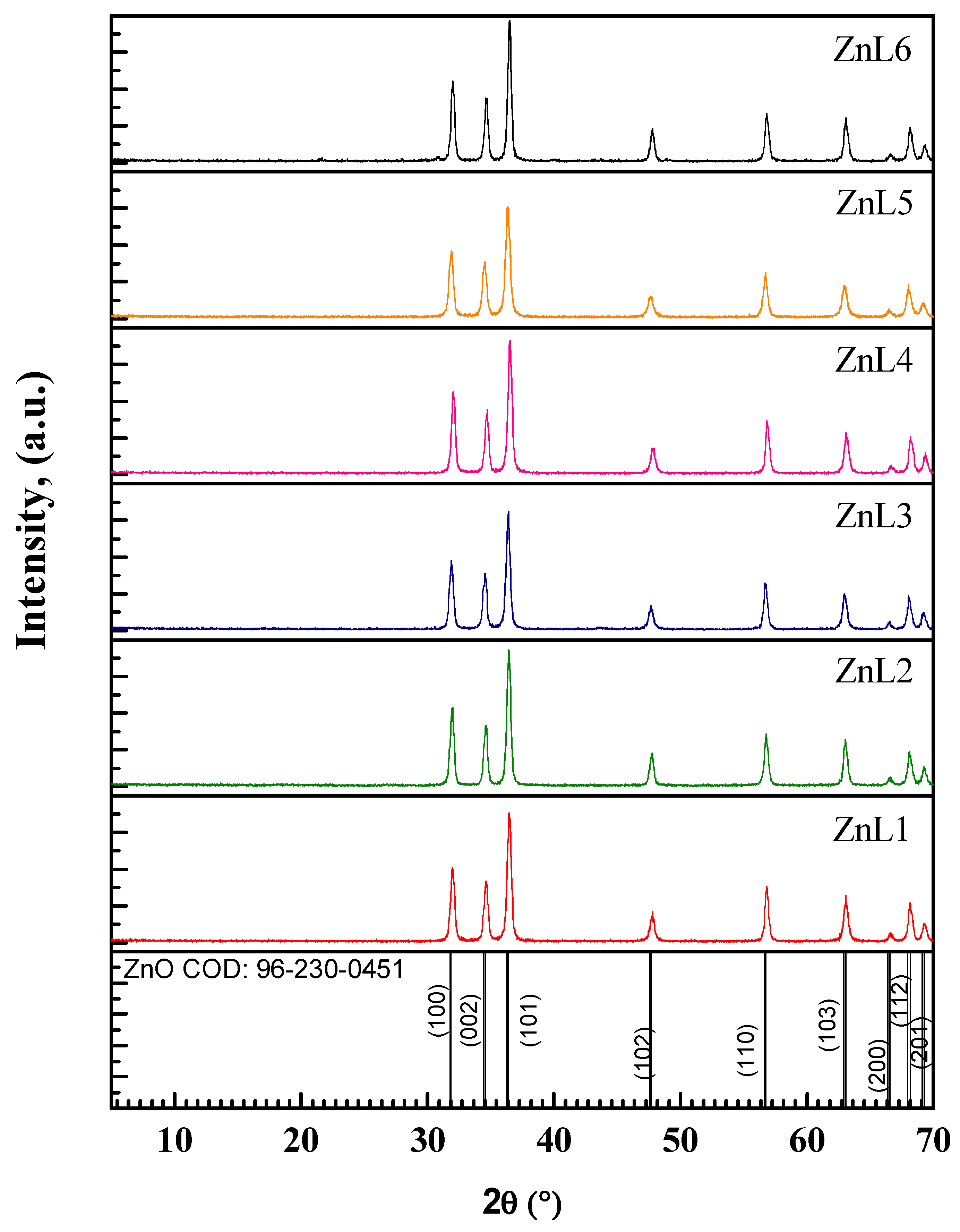
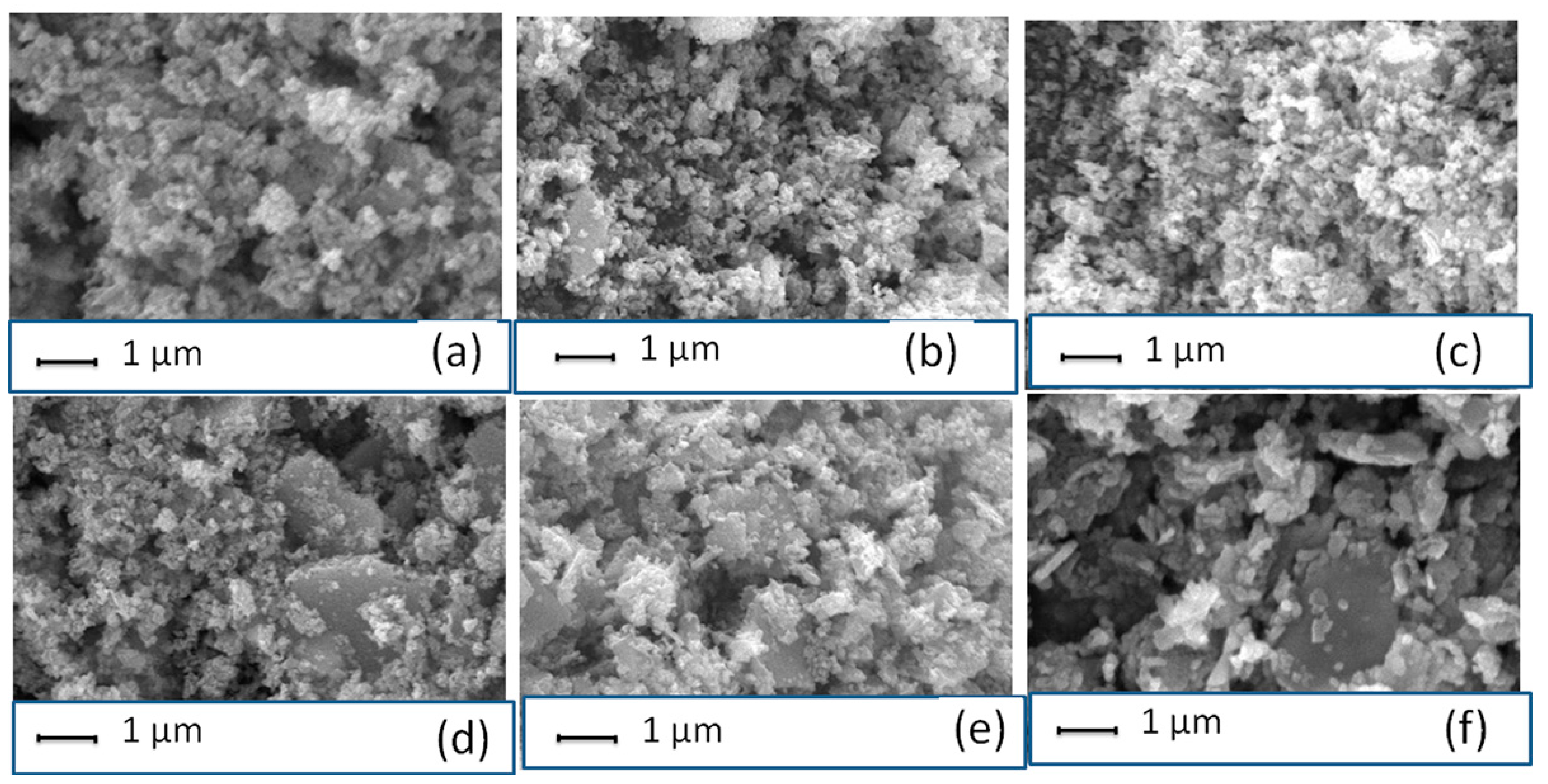

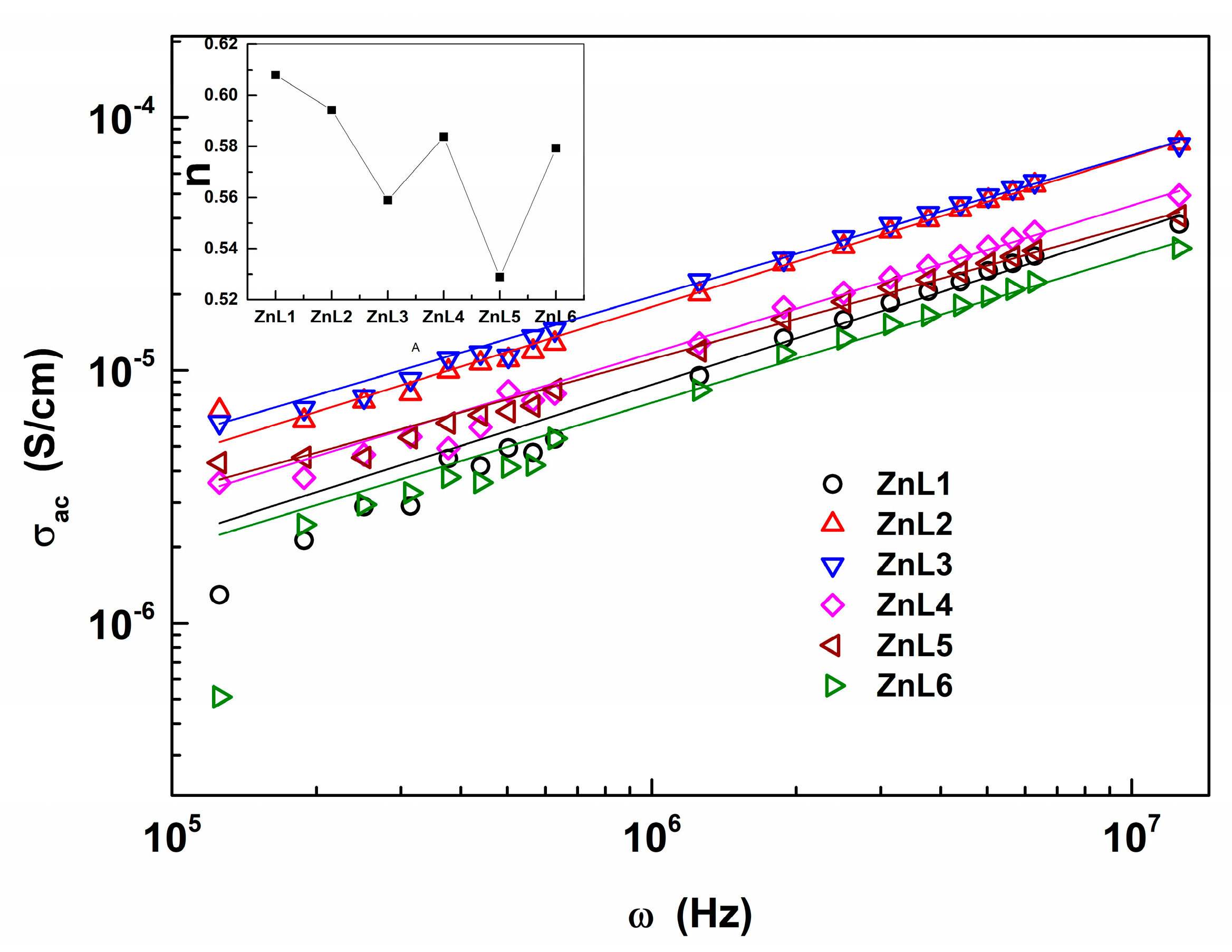
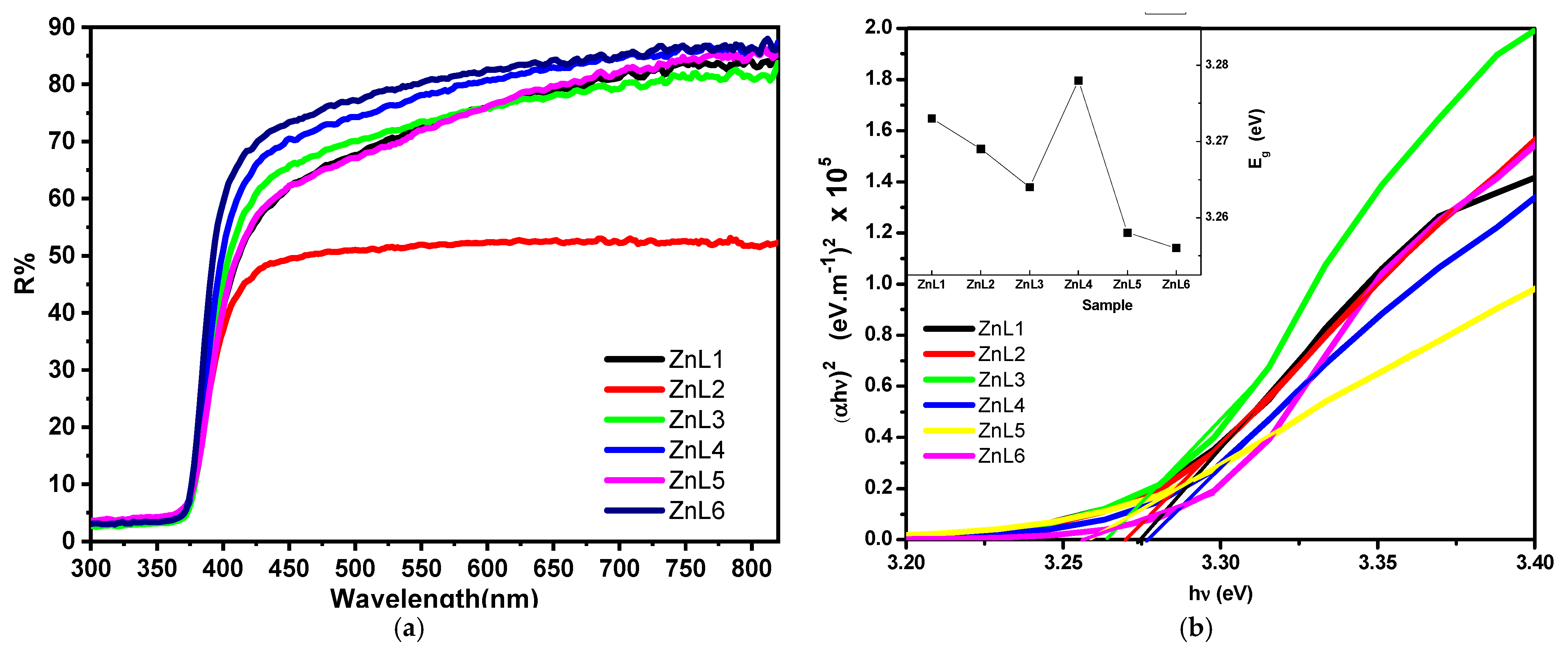
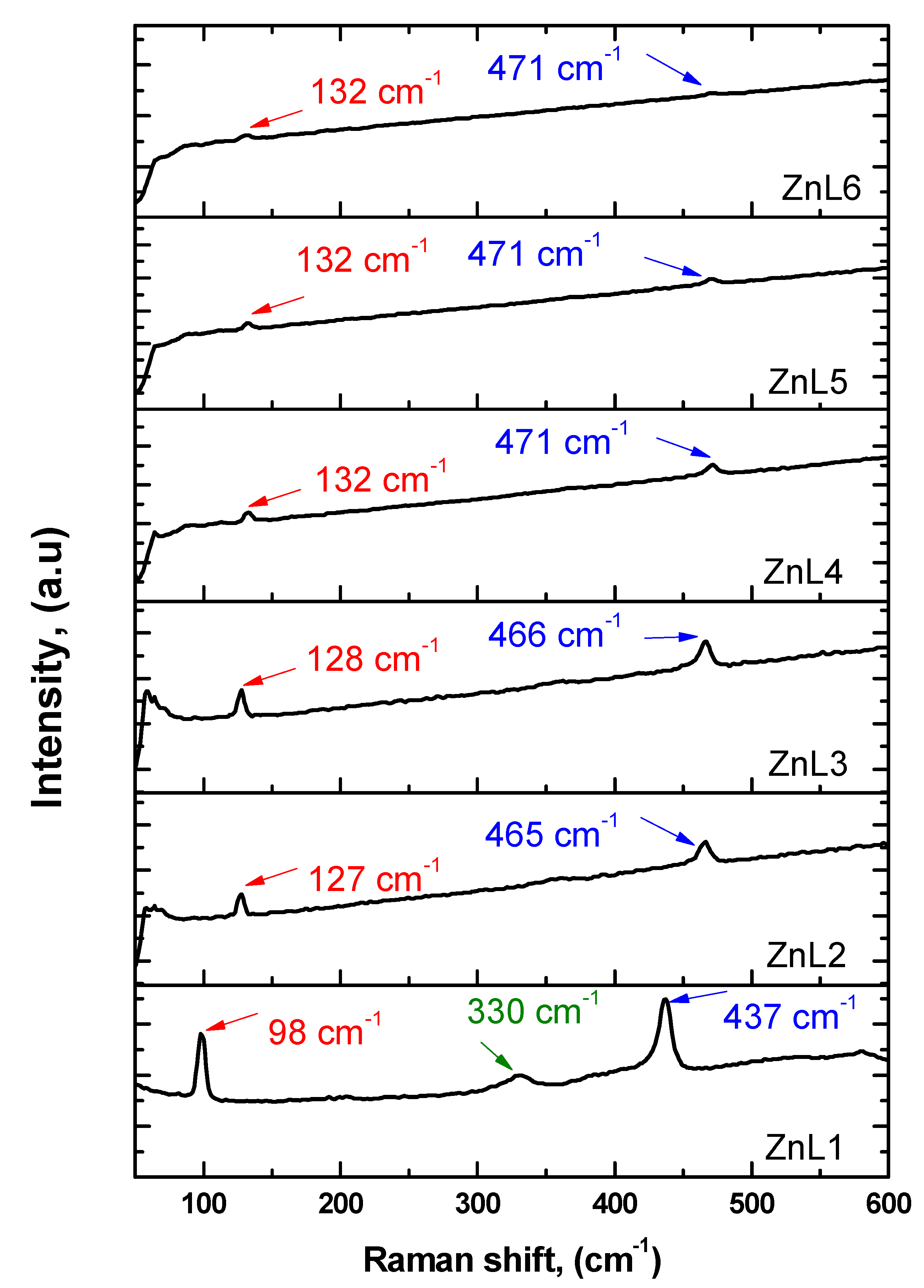
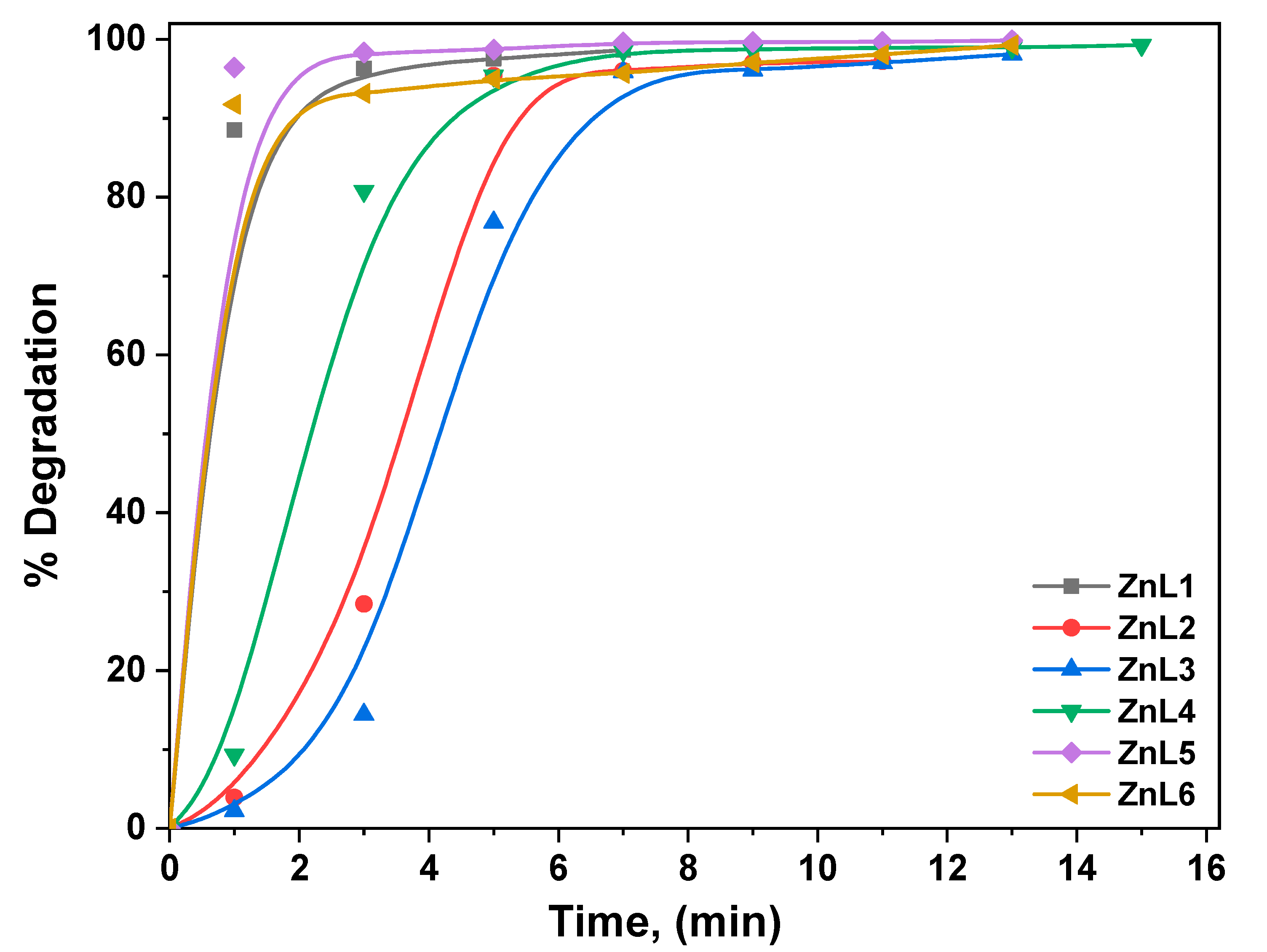
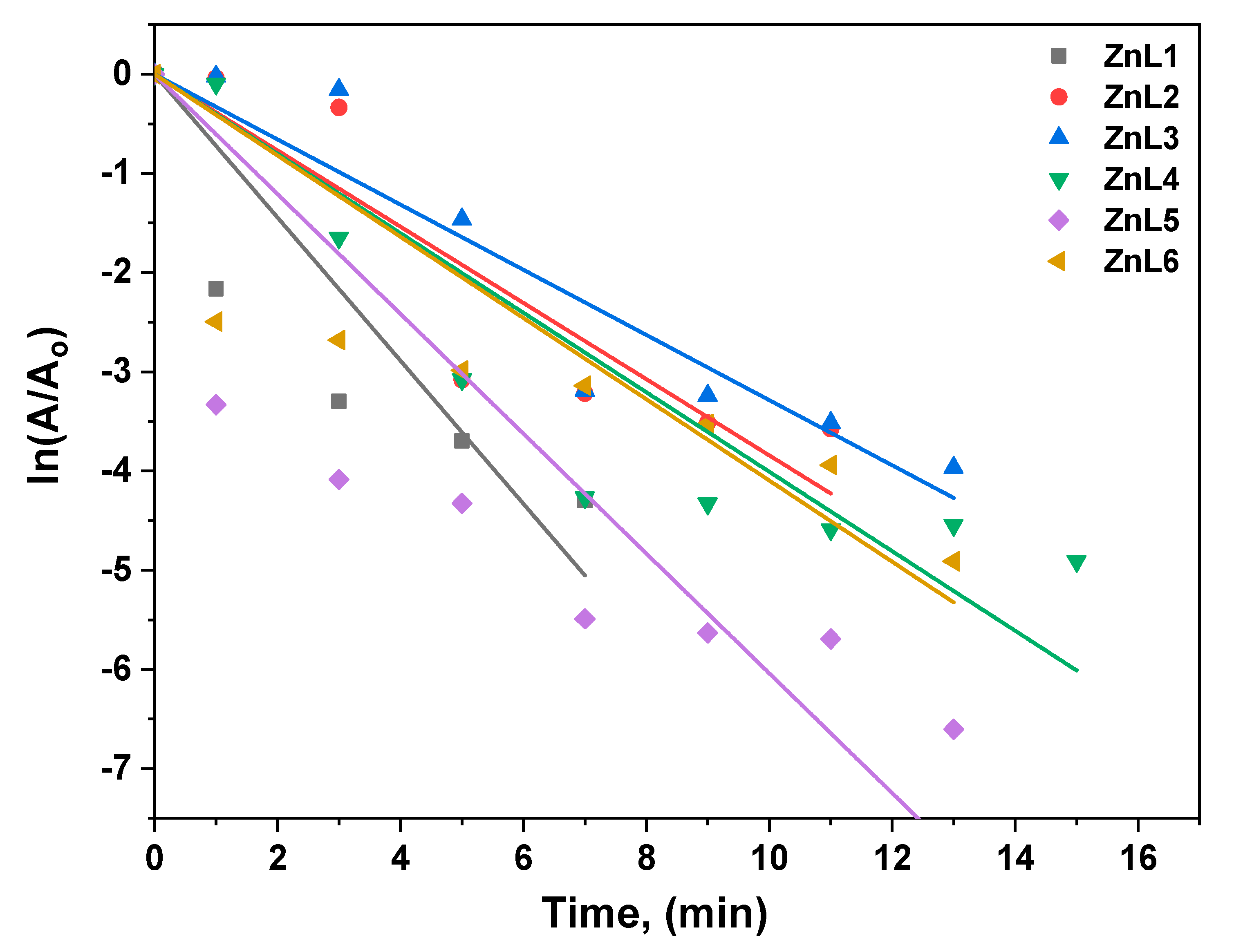
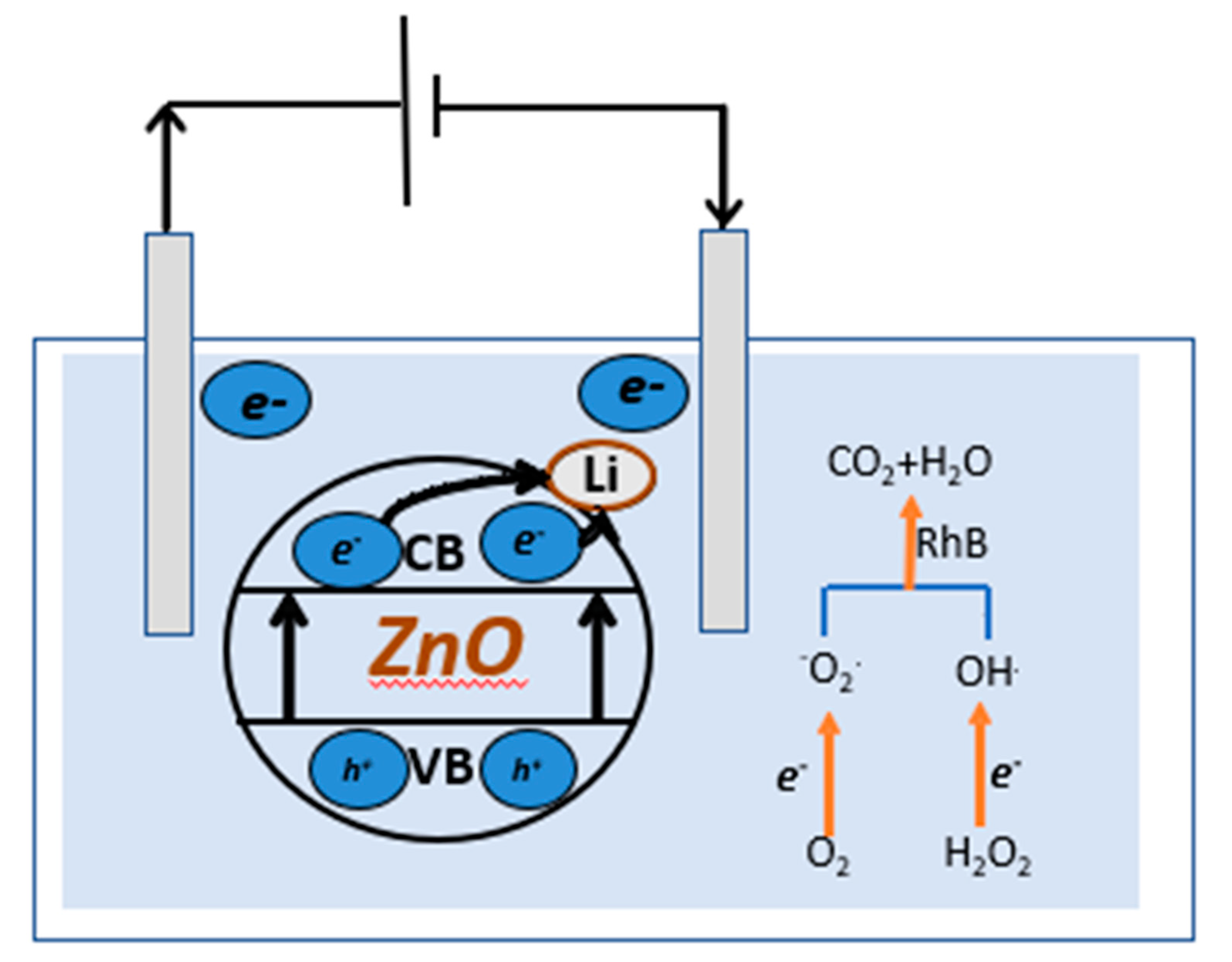
| Samples | Sample Codes |
|---|---|
| Zinc acetate + 30 mL distilled water | ZnL1 |
| Zinc acetate + glycine + 30 mL distilled water | ZnL2 |
| Zinc acetate + glycine + 30 mL distilled water + 0.001 LiNO3 | ZnL3 |
| Zinc acetate + glycine + 30 mL distilled water + 0.01 LiNO3 | ZnL4 |
| Zinc acetate + glycine + 30 mL distilled water + 0.1 LiNO3 | ZnL5 |
| Zinc acetate + glycine + 30 mL distilled water + 0.5 LiNO3 | ZnL6 |
| Samples | D (nm) | ε (10−3) | δ (1015 lines.m−2) | a (Å) | c (Å) | V (Å3) |
|---|---|---|---|---|---|---|
| ZnL1 | 22.81(23) | 5.07(5) | 1.99(4) | 3.229 | 5.177 | 46.746 |
| ZnL2 | 24.10(20) | 4.81(4) | 1.79(3) | 3.233 | 5.181 | 46.898 |
| ZnL3 | 23.49(23) | 4.94(5) | 1.92(4) | 3.238 | 5.189 | 47.116 |
| ZnL4 | 23.31(19) | 4.96(4) | 1.94(3) | 3.223 | 5.168 | 46.491 |
| ZnL5 | 20.70(24) | 5.61(6) | 2.42(6) | 3.240 | 5.193 | 47.211 |
| ZnL6 | 26.31(23) | 4.40(4) | 1.53(3) | 3.227 | 5.173 | 46.652 |
Disclaimer/Publisher’s Note: The statements, opinions and data contained in all publications are solely those of the individual author(s) and contributor(s) and not of MDPI and/or the editor(s). MDPI and/or the editor(s) disclaim responsibility for any injury to people or property resulting from any ideas, methods, instructions or products referred to in the content. |
© 2023 by the authors. Licensee MDPI, Basel, Switzerland. This article is an open access article distributed under the terms and conditions of the Creative Commons Attribution (CC BY) license (https://creativecommons.org/licenses/by/4.0/).
Share and Cite
Ganesh, V.; Ravi Kumar, B.; AlAbdulaal, T.H.; Yahia, I.S.; Abdel-wahab, M.S.; Ade, R.; Hussien, M.S.A.; Keshway, M. Electrocatalytic Degradation of Rhodamine B Using Li-Doped ZnO Nanoparticles: Novel Approach. Materials 2023, 16, 1177. https://doi.org/10.3390/ma16031177
Ganesh V, Ravi Kumar B, AlAbdulaal TH, Yahia IS, Abdel-wahab MS, Ade R, Hussien MSA, Keshway M. Electrocatalytic Degradation of Rhodamine B Using Li-Doped ZnO Nanoparticles: Novel Approach. Materials. 2023; 16(3):1177. https://doi.org/10.3390/ma16031177
Chicago/Turabian StyleGanesh, Vanga, Bandapelli Ravi Kumar, Thekrayat. H. AlAbdulaal, Ibrahim. S. Yahia, Mohamed Sh. Abdel-wahab, Ramesh Ade, Mai S. A. Hussien, and Mohamed Keshway. 2023. "Electrocatalytic Degradation of Rhodamine B Using Li-Doped ZnO Nanoparticles: Novel Approach" Materials 16, no. 3: 1177. https://doi.org/10.3390/ma16031177
APA StyleGanesh, V., Ravi Kumar, B., AlAbdulaal, T. H., Yahia, I. S., Abdel-wahab, M. S., Ade, R., Hussien, M. S. A., & Keshway, M. (2023). Electrocatalytic Degradation of Rhodamine B Using Li-Doped ZnO Nanoparticles: Novel Approach. Materials, 16(3), 1177. https://doi.org/10.3390/ma16031177







